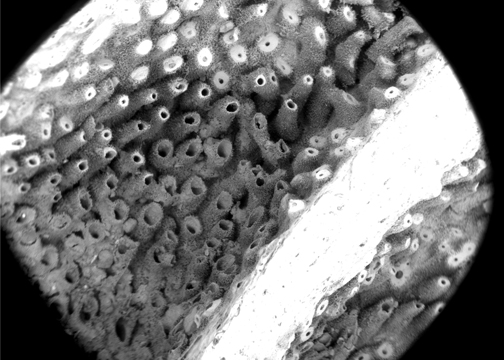Abstract
A fossil chimaeroid tooth plate (Ischyodus sp.) from the Cretaceous of Frankstown, Mississippi shows exceptional preservation of tritor microstructure. Diagenetic loss of the petrodentine/whitlockin in this specimen has revealed the ultrastructure of the vascular tubule networks of tritor interior structure. The observation that vascular tubes running through the hard tissues of chimaeroid tritors host odontoblast cells supports the hypothesis of an odontoblastic origin for chimaeroid tritor tissue.
References
- Case, G.R. (1978) Ischyodus bifurcatus, a new species of chimaeroid fish from the Upper Cretaceous of New Jersey. Géobios, 11, 21–29. https://doi.org/10.1016/S0016-6995(78)80016-3
- Cicimurri, D.J. (2010) Fossil chimaeroid remains (Chondrichthyes: Holocephali) from Williamsburg, South Carolina, USA. Paludicola, 8, 37–48.
- Cicimurri, D.J. & Ebersole, J.A. (2015) Paleocene chimaeroid fishes (Chondrichthyes: Holocephali) from the eastern United States, including two new species of Callorhinchus. PaleoBios, 32, 1–29. https://doi.org/10.5070/P9321028055
- Didier, D.A. (1995) Phylogenetic systematics of extant chimaeroid fishes (Holocephali, Chimaeroidei). American Museum of Natural History Novitates, 3119, 1–86.
- Duffin, C.J. (1984) A new myriacanthid holocephalan from the Sinemurian (Lower Jurassic) of Belgium. Zoological Journal of the Linnean Society, 82, 55–71. https://doi.org/10.1111/j.1096-3642.1984.tb00535.x
- Duffin, C.J. (1996) Holocephalans in the Staatliches Museum für Naturkunde in Stuttgart 4. The earliest German chimaeroid. Stuttgarter Beiträge zur Naturkunde Serie B (Geologie und Paläontologie), 240, 1–10.
- Ebersole, J.A., Solonin, S.V., Cicimurri, D.J., Arkhangelsky, M.S. & Martynovich, N.V. (2022) Marine fishes (Chondrichthyes, Holocephali, Actinopterygii) from the Upper Cretaceous (Campanian) Rybushka Formation near Beloe Ozero, Saratov Oblast, Russia. Rivista Italiana Paleontologia e Stratigrafia 128, 369–409. https://doi.org/10.54103/2039-4942/16954
- Gouiric-Cavalli, S., Cabrera, D., Cione, A., O’Gorman, J., Coria, R., Fernández, M., Iglesias, A. & Reguero, M. (2015) First record of the chimaeroid genus Edaphodon (Chondrichthyes, Holocephali) from Antarctica (Snow Hill Island Formation, Late Cretaceous, James Ross Island). Journal of Vertebrate Paleontology, 35, e981128. https://doi.org/10.1080/02724634.2015.981128
- Hoganson, J.W. & Erickson, J.M. (2005) A new species of Ischyodus (Chondrichthyes: Holocephali: Callorhynchidae) from the upper Maastrichtian shallow marine facies of the Fox Hills and Hell Creek Formations, Williston Basin, North Dakota, USA. Palaeontology, 48, 709–721. https://doi.org/10.1111/j.1475-4983.2005.00475.x
- Hussakov, L. (1912) The Cretaceous chimaeroids of North America. Bulletin of the American Museum of Natural History, 31, 195–227.
- Ishiyama, M. & Sasagawa, A.J. (1984) The inorganic content of pleromin in tooth plates of the living holocephalian, Chimaera phantasma, consists of a crystalline calcium phosphate known as beta-Ca3(PO4)2 (whitlockite). Archivum histologicum Japonicum, 47, 89–94. https://doi.org/10.1679/aohc.47.89
- Ishiyama, M., Yoshie, S., Teraki, Y. & Cooper, E.W.T. (1991) Ultrastructure of pleromin, a highly mineralized tissue comprising crystalline calcium phosphate known as whitlockite, in holocephalian tooth plates. In: Suga, S. & Nakahara, H. (Eds), Mechanisms and Phylogeny of Mineralization in Biological Systems, 453–457. https://doi.org/10.1007/978-4-431-68132-8_72
- Johanson, Z., Manzanares, E., Underwood, C., Clark, B., Fernandez, V. & Smith, M. (2021) Ontogenetic development of the holocephalan dentition: morphological transitions of dentine in the absence of teeth. Journal of Anatomy, 239, 704–719. https://doi.org/10.1111/joa.13445
- Johnson-Ransom, E.D., Popov, E.V., Deméré, T.A. & Shimada, K. (2018) The Late Cretaceous chimaeroid fish, Ischyodus bifurcatus Case (Chondrichthyes: Holocephali) from California, USA, and its paleobiogeographical significance. Paleontological Research, 22, 364–372. https://doi.org/10.2517/2018PR004
- Kemp, A. (2001) Petrodentine in derived dipnoan tooth plates. Journal of Vertebrate Paleontology, 21, 422–437. https://doi.org/10.1671/0272-4634(2001)021[0422:PIDDTP]2.0.CO;2
- Manning, E.M. (2006) Late Campanian Vertebrate Fauna of the Frankstown Site, Prentiss County, Mississippi; Systematics, Paleoecology, Taphonomy, Sequence Stratigraphy. Tulane University School of Science and Engineering, 420 pp.
- Manning, E.M. & Dockery, D.T. (1992) A Guide to the Frankstown Vertebrate Fossil Locality (Upper Cretaceous), Prentiss County, Mississippi. Mississippi Department of Environmental Quality, Office of Geology, Circular, 4, 1–56.
- Smith, M.S., Underwood, C., Goral, T., Healy, C. & Johanson, Z. (2019) Growth and mineralogy in dental plates of the holocephalan Harriotta raleighana (Chondrichthyes): novel dentine and conserved patterning combine to create a unique chondrichthyan dentition. Zoological Letters, 5, 1–30. https://doi.org/10.1186/s40851-019-0125-3
- Stahl, B.J. & Parris, D.C. (2004) The complete dentition of Edaphodon mirificus (Chondrichthyes: Holocephali) from a single individual. Journal of Paleontology, 78, 388–392. https://doi.org/10.1666/0022-3360(2004)078<0388:TCDOEM>2.0.CO;2
- Ward, D.J. & Duffin, C.J. (1989) Mesozoic chimaeroids I. A new chimaeroid from the Early Jurassic of Gloucestershire, England. Mesozoic Research, 2, 45–51.


